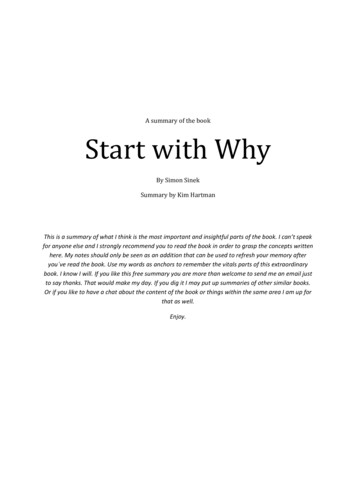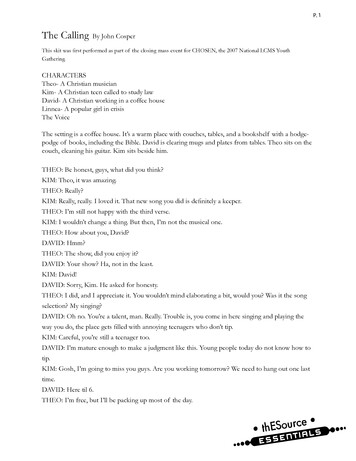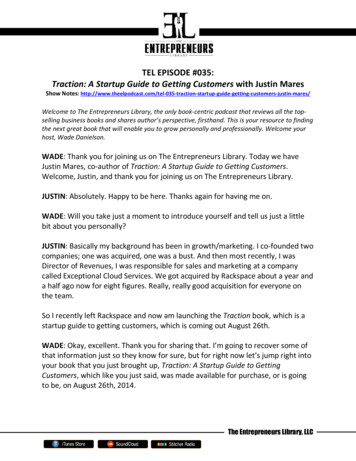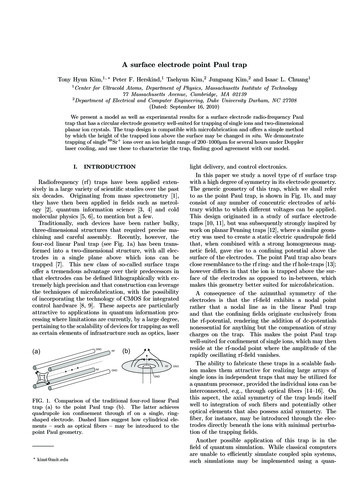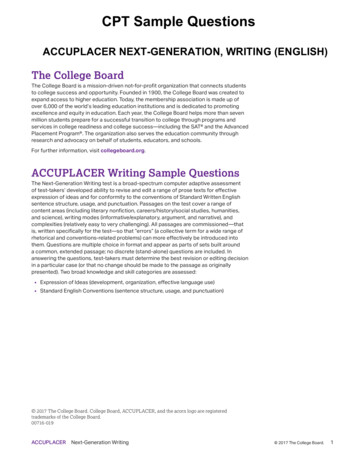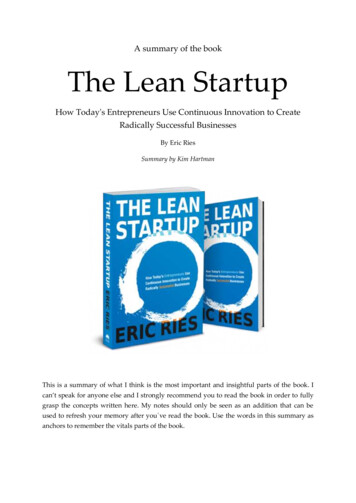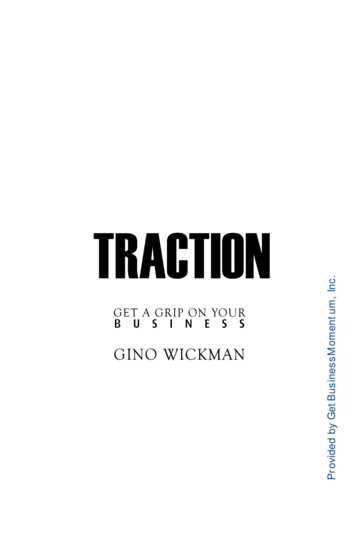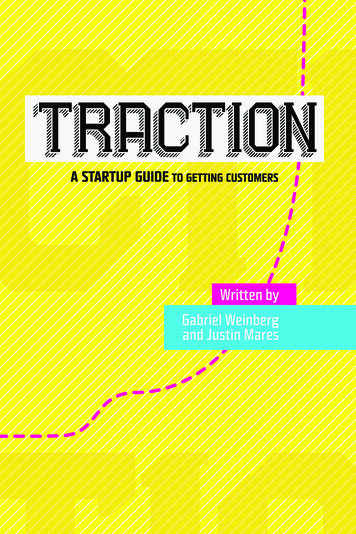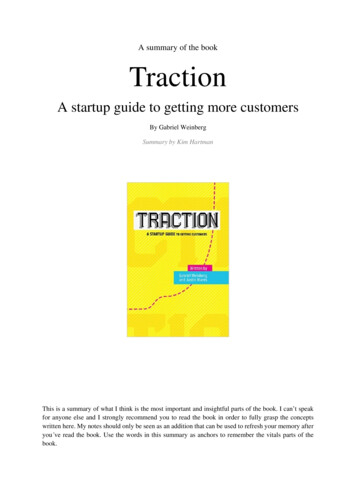
Transcription
A summary of the bookTractionA startup guide to getting more customersBy Gabriel WeinbergSummary by Kim HartmanThis is a summary of what I think is the most important and insightful parts of the book. I can’t speakfor anyone else and I strongly recommend you to read the book in order to fully grasp the conceptswritten here. My notes should only be seen as an addition that can be used to refresh your memory afteryou ve read the book. Use the words in this summary as anchors to remember the vitals parts of thebook.
ContentsConnect . 3Description from amazon . 4Chapter 2: The Bullseye Framework . 5Step 1: Brainstorm . 5Step 2: Rank . 5Step 3: Prioritize . 6Step 4: Test . 6Step 5: Focusing. 6Takeaways . 6Chapter 3: Traction Thinking . 83 phases . 8Takeaways . 10Chapter 4: Traction Testing . 11Takeaways . 11Chapter 5: Critical Path. 13Takeaways . 14Chapter 6: Viral Marketing . 15Takeaways . 18Chapter 7: Public Relations (PR) . 19Takeaways . 20Chapter 8: Unconventional PR . 21Takeaways . 21Chapter 9: Search Engine Marketing (SEM) . 23Takeaways . 24Chapter 10: Social & Display Ads . 25Takeaways . 25Chapter 11: Offline Ads . 27Takeaways . 27Chapter 12: Search Engine Optimization (SEO) . 28Takeaways . 29Chapter 13: Content Marketing . 30Takeaways . 30Chapter 14: Email Marketing. 311
Takeaways . 32Chapter 15: Engineering as Marketing . 33Takeaways . 33Chapter 16: Targeting Blogs . 34Takeaways . 34Chapter 17: Business Development (BD) . 35Takeaways . 36Chapter 18: Sales . 37The SPIN question model . 37PNAME. 37Sales funnel . 38Takeaways . 38Chapter 19: Affiliate Programs . 40Takeaways . 40Chapter 20: Existing Platforms . 42Examples. 42Takeaways . 43Chapter 21: Trade Shows . 44Takeaways . 45Chapter 22: Offline Events . 46Takeaways . 46Chapter 23: Speaking Engagements . 47Takeaways . 47Chapter 24: Community Building . 48Takeaways . 49More book summaries . 502
mm3
Description from amazonStartup advice tends to be a lot of platitudes repackaged with new buzzwords, but Traction issomething else entirely.As Gabriel Weinberg and Justin Mares learned from their own experiences, building asuccessful company is hard. For every startup that grows to the point where it can go public orbe profitably acquired, hundreds of others sputter and die.Smart entrepreneurs know that the key to success isn’t the originality of your offering, thebrilliance of your team, or how much money you raise. It’s how consistently you can growand acquire new customers (or, for a free service, users). That’s called traction, and it makeseverything else easier—fund-raising, hiring, press, partnerships, acquisitions. Talk is cheap,but traction is hard evidence that you’re on the right path.Traction will teach you the nineteen channels you can use to build a customer base, and howto pick the right ones for your business. It draws on inter-views with more than fortysuccessful founders, including Jimmy Wales (Wikipedia), Alexis Ohanian (reddit), PaulEnglish (Kayak), and Dharmesh Shah (HubSpot). You’ll learn, for example, how to:·Find and use offline ads and other channels your competitors probably aren’t using·Get targeted media coverage that will help you reach more customers·Boost the effectiveness of your email marketing campaigns by automating staggered sets ofprompts and updates·Improve your search engine rankings and advertising through online tools and researchWeinberg and Mares know that there’s no one-size-fits-all solution; every startup facesunique challenges and will benefit from a blend of these nineteen traction channels. Theyoffer a three-step framework (called Bullseye) to figure out which ones will work best foryour business. But no matter how you apply them, the lessons and examples in Traction willhelp you create and sustain the growth your business desperately needs.4
Chapter 2: The Bullseye Framework(And no, I haven’t forgot chapter 1. I just didn’t think it was very interesting.)Bullseye: A simple framework called Bullseye that will help you find the channel thatwill get you traction. You’re aiming for the Bullseye—the one traction channel that will unlockyour next growth stage. Using Bullseye to find your channel is a five-step s on what worksThe optimal channel: It is very likely that one channel is optimal. Most businessesactually get zero distribution channels to work. Poor distribution—not product—is the numberone cause of failure. If you can get even a single distribution channel to work, you have greatbusiness. If you try for several but don’t nail one, you’re finished. So it’s worth thinking reallyhard about finding the single best distribution channel.Step 1: BrainstormThe goal in brainstorming is to come up with reasonable ways you might use each tractionchannel. If you were to advertise offline, where would be the best place to do it? If you were togive a speech, who would be the ideal audience?It is important that you not dismiss any traction channel in this step. You should be able to thinkof at least one idea for every channel.It’s especially important to understand how similar companies acquired customers over time,and how unsuccessful companies wasted their marketing dollars.Step 2: RankThe ranking step helps you organize your brainstorming efforts. It also helps you start to thinka bit more critically about the traction channels in aggregate.Place each of the traction channels into one of three columns, with each column representing aconcentric circle in the Bullseye: Column A (Inner Circle): which traction channels seem most promising right now?Column B (Potential): which traction channels seem like they could possibly work?Column C (Long-shot): which traction channels seem like long-shots?5
Step 3: PrioritizeNow identify your inner circle: the three traction channels that seem most promising. If youalready have three channels in Column A, you’re done! If you have more than three, then youneed to get rid of some and vice-versa.Step 4: TestThe testing step is where you put your ideas into the real world. The goal of this step is to findout which of the traction channels in your inner circle is worth focusing on.You will make that decision based on results from a series of relatively cheap tests. These testsshould be designed to answer the following questions. Roughly how much will it cost to acquire customers through this channel? How many customers do you think are available through this channel? Are the customers that you are getting through this channel the ones that you wantright now?"When testing, you are not trying to get a lot of traction with a channel just yet. Instead, you aresimply trying to determine if it’s a channel that could work for your startup. Your mainconsideration at this point is speed to get data and prove out your assumptions.Step 5: FocusingIf all goes well, one of the traction channels you tested in your inner circle produced promisingresults. In that case, you should start directing your traction efforts and resources towards thatmost promising channel.At any stage in a startup’s lifecycle, one traction channel dominates in terms of customeracquisition"Repeating the Process:If, unfortunately, no channel seems promising aftertesting, the whole process should be repeated.Takeaways The Bullseye Framework is a five-step repeatable process to maximize your chancesof getting traction: brainstorm, rank, prioritize, test, and focus.6
Focusing on a traction channel means becoming an expert on it by continuallytesting new tactics to get the most traction possible. Research how past and present companies in your space and adjacent spacessucceeded or failed at getting traction. The easiest way to do this is to go talk tostartup founders who previously failed at what you’re trying to do. Compile your brainstorming ideas for each traction channel in a spreadsheet witheducated guesses that you can confirm through testing"7
Chapter 3: Traction ThinkingThe 50% rule: Traction and product development are of equal importance and shouldeach get about half of your attention. This is what we call the 50% rule: spend 50% of your timeon product and 50% on traction"Product Development & traction: Pursuing product development andtraction in parallel has several key benefits. It helps you build a better product because you canincorporate knowledge from your traction efforts"If you’re following a good product development process, you’re already getting good feedbackfrom early users. Traction development gets you additional data, like what messaging isresonating with potential users, what niche you might focus on first, what types of customerswill be easiest to acquire, and major distribution roadblocks you might run into.Long-term: doing traction and product development in parallel may slow down productdevelopment in the short run, but not in the long run"The second benefit to parallel product and traction development is that you get to experimentand test different traction channels before you launch anything. This means when your productis ready, you can grow rapidly"The Lean Startup framework is a popular one. This approach involvescreating testable hypotheses regarding your product, and then going out and validating (orinvalidating) those hypotheses"Bullseye Lean: Bullseye works hand-in-hand with Lean. What Lean is to productdevelopment, Bullseye is to traction. With Lean, you figure out the right features to build. WithBullseye, you figure out the right traction channel to pursue.The Product Trap: if you build it, they will come. Your traction strategy shouldalways be focused on moving the needle for your company. By moving the needle, we meanfocusing on marketing activities that result in a measurable, significant impact on yourcompany. It should be something that advances your user acquisition goals in a meaningfulway.3 phases Phase I – making something people want Phase II – marketing something people want Phase III – scaling your business8
Phase 1Phase I is very product focused and involves pursuing initial traction while also building yourinitial product.This often means getting traction in ways that don’t scale – giving talks, writing guest posts,emailing people you have relationships with, attending conferences.Phase 2If you’ve made it to phase II, you have a product that resonates with customers – initial traction– and therefore doesn’t require sweeping product changes. In other words, in phase II you haveestablished product/market fit and now are fine-tuning your positioning and marketingmessages.Phase 3In phase III, you have an established business model, significant position in the market, and arefocused on scaling both to further dominate the market and to profit.Startup growth happens in spurts. Initially, growth is usually slow. Then, it spikes asa useful traction channel is unlocked. Eventually it flattens out again as a channel gets saturatedand becomes less effective. Then, you unlock another strategy and you get another spike.After your growth curve flattens, what worked before usually will not getyou to the next level.Product engagement means different things for different startups, but generally itmeans real customers using your product because it is solving some problem or need for them.Sustainable product engagement growth (i.e. more customers getting engaged over time) is hardfor any investor to ignore.This is true even if your absolute numbers are relatively small. So if you only have 100customers, but have been growing 10% a month for six months, that’s attractive to investors.Giving up: many startups give up way too early. A lot of startup success hinges onchoosing a great market at the right time.Pivot: If you are considering a pivot, the first thing to look for is evidence of real productengagement, even if it is only a few dedicated customers. If you have such engagement, youmight be giving up too soon. You should examine these bright spots to see how they might beexpanded. Why do these customers take to your product so well?Being a year or two early can be a great thing. You can use this time to improveand refine your product. Then, when the market takes off, you have a head start on competitorsjust entering your space"9
Takeaways Don’t fall into The Product Trap: pursue traction and product development in parallel,and spend equal time on both. The Bullseye Framework and a product development framework (e.g. Lean Startup) canwork together to maximize your probability of success. Focus on strategies and tactics that can plausibly move the needle for company. Whatchange in growth metrics would move the needle for your company? How much traction is needed for investors is a moving target, but a sustainable customergrowth rate is hard for investors to ignore. Potential investors who understand yourbusiness are likely to appreciate your traction and thus invest earlier. If you’re not seeing the traction you want, look for bright spots in your userbase, pocketsof users that are truly engaged with your product. See if you can figure out why it worksfor them and if you can expand from that base. If there are no bright spots, it may be agood time to pivot."10
Chapter 4: Traction TestingContinuous testing is the key to getting traction with Bullseye.The Law of Shitty Click-Throughs: Over time, all marketing strategiesresult in shitty click-through rates. What this means is that over time, all marketing channelsbecome saturated.Small experiments: To combat this reality you should consistently conduct smallexperiments. Constantly running small traction tests will allow you to stay ahead of competitorspursuing the same channels"Validate or invalidate: When trying to figure out what traction channel to focuson using Bullseye, you run cheap tests on the traction channels in your inner circle. The goal ofthese tests is to validate or invalidate assumptions you have about strategies in these tractionchannels. For example: How much does it cost to acquire customers through this channel strategy? How many customers are available through this channel strategy"Once you know your assumptions, devise specific tests to validate them as cheaply as possible.These first tests in a channel are often very cheap: for instance, if you spend just 250 onAdWords, you’ll get a rough idea of how well the search engine marketing channel works foryour business.Fast experiments: The faster you run high quality experiments, the more likelyyou’ll find scalable, effective growth tactics. Determining the success of a customer acquisitionidea is dependent on an effective tracking and reporting system, so don’t start testing until yourtracking/reporting system has been implemented.Always a point: ach cheap test you run should have a point – to validate or invalidatespecific assumption(s) in your model.A/B testing: Making A/B testing a habit (even if you just run 1 test a week) will improveyour efficiency in a traction channel by 2–3x.Takeaways Keep a look out for the cutting edge tactics that haven’t yet succumbed to the Law ofShitty Click-Throughs. Run cheap tests to validate quantitative assumptions from a model (e.g. a spreadsheet).11
You should consistently run A/B tests in your efforts to optimize a traction channel.There are many online tools that can help you test easier and evaluate your use of varioustraction channels. Look for ways to quantify your marketing efforts, especially when deciding whattraction strategies to pursue and comparing traction channels within Bullseye. Youshould have an idea at all times of what numbers it will take to move the needle, andfocus your traction efforts only on strategies that could possibly do so.12
Chapter 5: Critical PathStartups get pulled in a lot of different directions. How do you decide what to work on?Your Traction GoalYou should always have a traction goal you’re working towards. This could be 1,000 payingcustomers, 100 new daily users, or 10% of your market.If you reach this goal, what will change significantly?Defining MilestonesThe path to reaching your traction goal with the fewest number of steps is your Critical Path. Ithelps to literally draw this path out.Should be absolutely necessary to reach your goal.The point is to be critical and strategic in deciding what to include. That’s why it is called theCritical Path.Order MilestonesNext, order your milestones by which need to be done first, second and so forth.Once you’ve defined your critical path, it’s easy to determine thedirection to go in – just follow the path! In particular, work on the first step(s) and nothing else.After these first steps are complete, re-assess your critical path using the market knowledge youjust learned from achieving that milestone. Your original plan is often wrong.Path or not: Everything you do should be assessed against your Critical Path. Everyactivity is either on path or not. If it is not on the path, don’t do it!"Right traction goal: The importance of choosing the right traction goal cannot beoverstated. Are you going for growth or profitability, or something in between.Once defined, you can work backwards and set clear quantitative and time-based traction subgoals, like reaching 1,000 customers by next quarter or hitting 20% monthly growth"Critical Path: Critical Path is a high-level framework that helps you decide where toallocate your time and energy to get traction faster. Your traction goal dictates your companydirection. That’s because building product, getting funding and everything else your companydoes is in the pursuit of traction. Remember, traction trumps everything.Get Good Mentors: The simple act of preparing to meet with your mentor(s) on aregular basis is a forcing function that compels you to think more critically.13
Overcoming Your Biases: When creating this part of the Critical Path, manyfounders unfortunately ignore promising traction channels due to natural biases. This is anexpensive proposition since it wastes resources sending you down the wrong path.This bias may be preventing you from getting traction. You can get a competitive advantage byacquiring customers in ways your competition isn’t.Advantage: It can almost be a competitive advantage (at least a temporary one) if youcan acquire customers in channels that others cannot, or refuse to try"Takeaways Determine your traction goal and define your Critical Path against that goal, workingbackwards and enumerating the company absolutely necessary milestones you need toachieve to get there. Stay on Critical Path by assessing every activity you do against it and by consistentlyre-assessing it. Building such assessment into your management processes is a goodidea. Quantify traction sub-goals and put them on a calendar and/or in a spreadsheet so youcan properly monitor your progress over time. Find a good mentor or set of mentors. Actively work to overcome your traction channel biases. Mentors can help here. Being on the cutting edge of the right traction channel can make a huge difference insuccess. Which traction channels do you know most about? Which traction channels doyou know least about?"14
Chapter 6: Viral MarketingViral marketing is the process of getting your existing users to refer others to yourproduct.Going viral means that every user you acquire brings in at least one other user. Thiscreates true exponential growth.Viral LoopsA viral loop in its most basic form is a three-step process: A user is exposed to your product. That user tells a set of potential users about your product. These potential users are exposed to your product and become users themselves.The process then begins again with these new users. It’s called a loop because it repeats overand over again; as your users refer other users, those users refer others, and so on.Inherent virality occurs when you can only get value from a product by inviting otherusers. For example, if your friends don’t have Skype, the application is worthless"Encouraging collaboration:Other products grow by encouragingcollaboration. In this case, the product is still valuable on its own but becomes more so as youinvite others. Google Docs is useful alone, but it is far more valuable when used collaboratively.Embedded virality:Another common case is to embed virality intocommunications from the product. Hotmail put a “Get a free email account with Hotmail. Signup now.” as a default signature and Apple similarly appends “sent from my iPhone. Manysoftware products do this with their free users.Products can also incentivize their users to move through their viral loops and tell others aboutthe product. Dropbox gives you more space if you get friends to sign up.Companies like reddit and YouTube have grown virally by using embedded buttons andwidgets.Social networks: Another type of viral loop leverages social networks to attract newusers to a product. If you’ve spent any time on Facebook, we’re sure you’ve seen your friendsliking articles on other sites, playing songs on Spotify, or pinning content on Pinterest.15
Viral MathThis viral math helps you quickly identify how close you are to getting traction through viralmarketing, as well as which areas you need to focus on. The two key factors that drive viralgrowth are the viral coefficient and the viral cycle time.The Viral Coefficient (K)The viral coefficient, or K, is number of additional users you can get for each user you bring in.The viral coefficient formula is:K i * conversion percentage where K is the viral coefficient, i is the number of invites sent per user, and conversionpercentage is the percentage of users who sign up after receiving an invitation. For example, ifyour users send out an average of 3 invites and 2 of those people usually convert to new users,your viral coefficient would be:K 3 * (2/3) 2"Any viral coefficient over 0.5 helps your efforts to grow considerably.Two variables: There are two variables that impact your viral coefficient.1. The first is the number of invites (i) that each user sends out. If you can increase theaverage number of invites that each user sends out, say from 1 invite per user to 2, youwill double your viral coefficient"2. The second variable is the conversion percentage. If your product is being shared butnot generating new users, you won’t go viral. As with invites, if you double yourconversion percentage (by doing things like testing different signup flows), you doubleyour viral coefficient. The best signup flows reduce friction by making things simpler,such as cutting out pages or sign up fields. For example, the conversion steps for astandard web application often involve clicking on a link and filling out a form to createan account. In that case, you could break the conversion perc
A summary of the book . Traction . A startup guide to getting more customers . By Gabriel Weinberg . Summary by Kim Hartman . This is a summary of what I think is the most important and insightful parts of the book. I can’t speak for anyone else and I strongly recommend you to read the book in order to fully grasp the concepts written here.File Size: 428KBPage Count: 51
